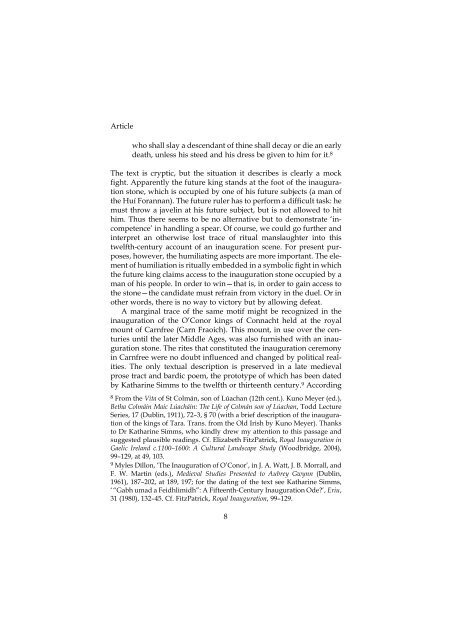The Power of Weakness: Machiavelli Revisited - German Historical ...
The Power of Weakness: Machiavelli Revisited - German Historical ...
The Power of Weakness: Machiavelli Revisited - German Historical ...
Create successful ePaper yourself
Turn your PDF publications into a flip-book with our unique Google optimized e-Paper software.
Article<br />
who shall slay a descendant <strong>of</strong> thine shall decay or die an early<br />
death, unless his steed and his dress be given to him for it. 8<br />
<strong>The</strong> text is cryptic, but the situation it describes is clearly a mock<br />
fight. Apparently the future king stands at the foot <strong>of</strong> the inauguration<br />
stone, which is occupied by one <strong>of</strong> his future subjects (a man <strong>of</strong><br />
the Huí Forannan). <strong>The</strong> future ruler has to perform a difficult task: he<br />
must throw a javelin at his future subject, but is not allowed to hit<br />
him. Thus there seems to be no alternative but to demonstrate ‘in -<br />
competence’ in handling a spear. Of course, we could go further and<br />
interpret an otherwise lost trace <strong>of</strong> ritual manslaughter into this<br />
twelfth-century account <strong>of</strong> an inauguration scene. For present purposes,<br />
however, the humiliating aspects are more important. <strong>The</strong> element<br />
<strong>of</strong> humiliation is ritually embedded in a symbolic fight in which<br />
the future king claims access to the inauguration stone occupied by a<br />
man <strong>of</strong> his people. In order to win—that is, in order to gain access to<br />
the stone—the candidate must refrain from victory in the duel. Or in<br />
other words, there is no way to victory but by allowing defeat.<br />
A marginal trace <strong>of</strong> the same motif might be recognized in the<br />
inauguration <strong>of</strong> the O’Conor kings <strong>of</strong> Connacht held at the royal<br />
mount <strong>of</strong> Carnfree (Carn Fraoich). This mount, in use over the centuries<br />
until the later Middle Ages, was also furnished with an inauguration<br />
stone. <strong>The</strong> rites that constituted the inauguration ceremony<br />
in Carnfree were no doubt influenced and changed by political realities.<br />
<strong>The</strong> only textual description is preserved in a late medieval<br />
prose tract and bardic poem, the prototype <strong>of</strong> which has been dated<br />
by Katharine Simms to the twelfth or thirteenth century. 9 According<br />
8 From the Vita <strong>of</strong> St Colmán, son <strong>of</strong> Lúachan (12th cent.). Kuno Meyer (ed.),<br />
Betha Colmáin Maic Lúacháin: <strong>The</strong> Life <strong>of</strong> Colmán son <strong>of</strong> Lúachan, Todd Lecture<br />
Series, 17 (Dublin, 1911), 72–3, § 70 (with a brief description <strong>of</strong> the inauguration<br />
<strong>of</strong> the kings <strong>of</strong> Tara. Trans. from the Old Irish by Kuno Meyer). Thanks<br />
to Dr Katharine Simms, who kindly drew my attention to this passage and<br />
suggested plausible readings. Cf. Elizabeth FitzPatrick, Royal In aug uration in<br />
Gaelic Ireland c.1100–1600: A Cultural Landscape Study (Wood bridge, 2004),<br />
99–129, at 49, 103.<br />
9 Myles Dillon, ‘<strong>The</strong> Inauguration <strong>of</strong> O’Conor’, in J. A. Watt, J. B. Morrall, and<br />
F. W. Martin (eds.), Medieval Studies Presented to Aubrey Gwynn (Dublin,<br />
1961), 187–202, at 189, 197; for the dating <strong>of</strong> the text see Katharine Simms,<br />
‘“Gabh umad a Feidhlimidh”: A Fifteenth-Century Inauguration Ode?’, Eriu,<br />
31 (1980), 132–45. Cf. FitzPatrick, Royal Inauguration, 99–129.<br />
8













